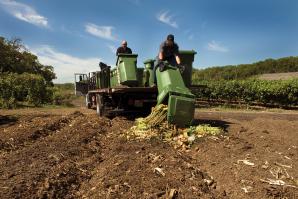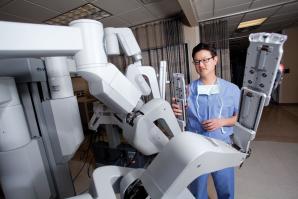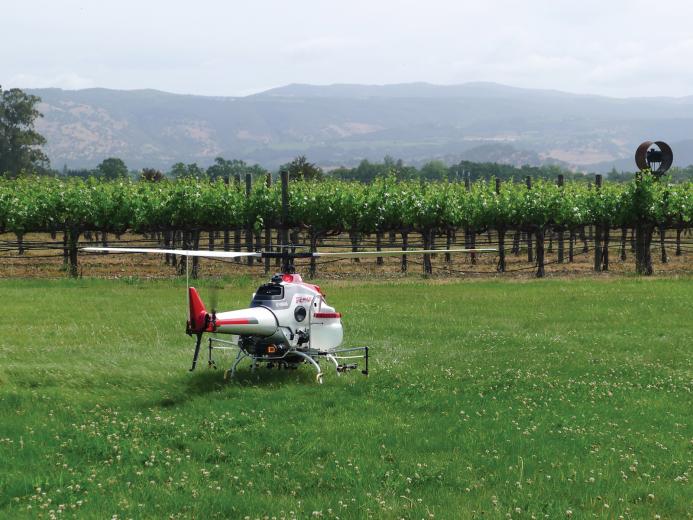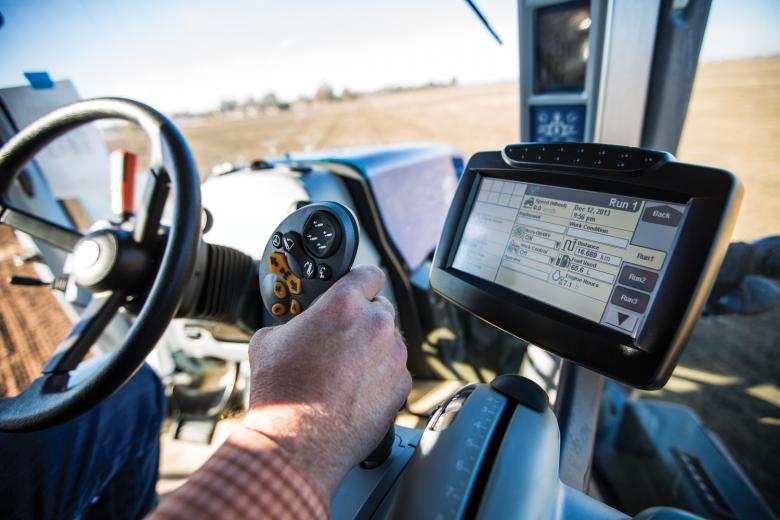Society is confronted by four stubborn facts:
- Fact 1) There are currently about 7.2 billion people on the planet.
- Fact 2) By the year 2050, this is expected to grow to 9.6 billion.
- Fact 3) Those people will still need to eat.
- Fact 4) The planet is not growing additional land.
Conclusion? Something needs to change. Barring miraculous leaps forward from 3D printing, this means we will need to harvest more food from the soil we have. Scientists, engineers and entrepreneurs are racing to give farmers tools to boost agricultural productivity.
These five technologies — some big, some small — could change the face of farming.
1. Drones
An army of drones is coming. They don’t shoot lasers, blast missiles or bomb enemy terrorists, but according to estimates from the FAA, in about five years we’ll have 10,000 drones zipping through the sky, increasing output and boosting revenue. If you believe a study from the Association for Unmanned Vehicle Systems International, between the years 2015 and 2025, drones will create 18,000 jobs and drive $14 billion of economic activity in California alone.
In an odd way, drones and farming make perfect sense. The sprawling farms of Big Ag make it impossible for a farmer to personally inspect every acre of soybeans, so the drones can be his eyes and ears. They hover close to the ground (below 400 feet, as per current FAA regulations) and snap pictures of the farm’s terrain, crops and soil. Early prototypes, like the LP960 from Lehmann Aviation, cost about $10,000 and are equipped with GPS sensors. They can map the land, collect pollen counts, track the status of plants and identify unhealthy crops. They’re data-collecting beasts.
But could the drones be unleashed to do even more? An engineering team at UC Davis is betting they can. They’re using a Yamaha R-Max minichopper weighing 200 pounds to not just gather data but actually squirt the crops with chemicals. Project lead Dr. Ken Giles says that because the drone will spray only precisely where it’s needed, it can treat crops with “maybe a hundredth” of the usual dose of pesticides. As for those concerned about privacy, “as a citizen, I share those reservations and agree that we need to be very careful about how we use unmanned aircraft,” said Dr. Giles after a field test in June 2013. “But with the color, size and noise of a motorcycle, this helicopter that we’re testing is anything but stealthy and would be a great disappointment to anyone hoping to use it for espionage or other covert purposes.”
Still, the drones are getting smaller, lighter, cheaper. Chris Anderson, who used to be the editor-in-chief of Wired magazine, swapped his red pen for a remote control. His company, 3D Robotics, created a miniature airplane out of foam that can fly with a $170 autopilot. Anderson sees this as an agricultural game-changer, saying at a press conference, “When I got into this, I thought it would be the future of flight, but now I think drones might be the future of food.”
The key word here is might. As Ann Marie Gardner, the editor-in-chief of Modern Farmer, told me, “The promises being made are pretty big. Drones can help with weed control and fertilizer use; they will save time and money. Only time will tell if these promises come to bear or if they’re affordable for farmers.”
2. Web Markets
Not as sexy as an army of flying weed-zappers, but in the near-term it could pack more of a punch. Sacramento’s farm-to-fork movement, while a boon for both growers and consumers, still leaves organic farmers with a gamut of distribution and marketing challenges. New websites can help.
“Some of the most exciting uses of technology out there for farmers are those that help connect them directly with buyers,” says Gardner. “Websites that let individual buyers, markets and chefs connect directly with a farmer solve that ‘last mile’ problem for producers. A lot of farmers aren’t natural marketers, and companies that help put farmers and buyers in touch take that out of the equation.”
Sacramento is already ahead of the pack, of course, with useful websites like farmtoforkcapital.com that list farmers markets and local events, and farm-specific websites like farmfreshtoyou.com, which let you order organic zucchini and have it delivered to your doorstep. But a new site on the block, goodeggs.com, takes it to the next level: It allows consumers to mosey through a virtual farmers market to select pasture-raised eggs or golden russet apples. When you click on a product, you’ll see an honest-to-God photo of the farmer who raised your lamb and a description of the farm. The site is slick, simple and fun, or as the New York Times called it, an “orgy of visual pleasure.” It’s a foodie’s dream. The starter cities are San Francisco, Brooklyn, Los Angeles and New Orleans, but Sacramento seems like a no-brainer, and other sites are sure to follow.
Is this just a tiny niche? Unlikely to transform the way we buy groceries? Perhaps. But that’s also what they said about a company called Amazon, which, incidentally, recently started a local food service called “Amazon Fresh.” (And is also looking into its own army of drones.)
3. Robots
Say hello to the Lettuce Bot. He doesn’t look like your average farmer. He doesn’t wear faded jeans, he can’t speak, he doesn’t have a head, and, okay, he needs to get pulled around by a tractor. But then again, he might soon be the guy behind your next salad. Developed in Mountain View by Blue River Technology, this robo-farmer is able to chew through a field of lettuce in the same time it takes 20 humans to do the same task. (Why lettuce? Each year it’s worth about $1.6 billion in California.) As it rumbles forward at about 2 mph, the robot’s cameras snap pictures of the vegetation and then its algorithm-driven brain will instantaneously thin the lettuce or spray fertilizer that kills the weeds. It’s like The Terminator: Kill the enemies, protect John Connor.
Robots could also soon be picking fruit. Ted Batkin, who has ag-cred as the former president of the Citrus Research Board, is developing a robot that looks a bit like Doctor Octopus from Spider Man: four arms, four legs and it picks oranges and pears at four to eight times the speed of your average humanoid. It can work at night. It doesn’t need vacation days. It won’t ask for a raise. So what’s the catch? Robots can be adept at large-scale processes (like lettuce-thinning), but they’re fuzzy on judgment calls like whether fruit is ripe. The second catch: Batkin says the robot is still two years away and will cost around $300,000, so it’ll be some time before Soil Born Farms or the orchards at Apple Hill are turning the keys to robots. “I know of no farm that’s currently using a fully-functioning, self-propelled robot,” says Jeff Huckins, CEO of Woodland Tractor, but he expects to see them in action within the next five years.
This might be inevitable. The pool of farm labor is shrinking as fewer and fewer workers are migrating from Mexico — roughly a million crossed the border in 2006, but that number plunged to 375,000 in 2011. As the cost of robots goes down and the cost of humans goes up, the basic laws of supply and demand will likely spur adoption. Farm laborers, understandably, are skeptical. “The fundamental question for consumers is who — and now, what — do you want picking your food. A machine or a human?” asked Erik Nicholson, national vice president of the United Farm Workers of America, to the Associated Press. And as anyone who has ever called Customer Service to speak to an “automated agent” knows (“Press 1 to review your balance; press 2 to slit your wrists in frustration,”) there’s still a good bit of difference between a person and a ‘bot.
4. Big Data
“Big Data” is one of those buzzwords that CEOs and politicians
love to toss around. Ninety-two percent of marketers in a recent
Forbes survey said they use Big Data to improve their sales.
Slicing and dicing massive blocks of data is now the hobbyhorse
of economists, meteorologists, telecommunications analysts and
everyone from astronomers to army generals. There’s even a
virtual chef who lives inside an IBM computer, and he probes data
from millions of recipes and, using an algorithm, creates
original treats like Spanish almond crescents. So of course
Big Data has entered our cornfields.
Farmers have always craved information. The more a farmer knows about the wind, soil and expected rainfall, the more potatoes he can squeeze out of the dirt. That’s the logic behind Monsanto’s recent decision to shell out $930 million to buy data-crunching firm The Climate Corp., which creates iPhone apps that let farmers get real-time data on their soil conditions while sitting at the breakfast table. By harnessing the company’s deep well of data, features like the “nitrogen advisor” and “pest and disease advisor” help inform planting decisions and increase yield, which, according to the company, creates $100 of value per acre. Big Data is also used to create more sophisticated and granular options for crop insurance. “Farmers are starting to come online. It feels a lot like email in 1993,” said David Friedberg, the founder of Climate Corp., on Bloomberg TV. “Farming is inherently very risky and very volatile. To survive, you have to be smart and thoughtful. And you have to have control of all of these various levers.”
This doesn’t have to cost a fortune, and the myth that farmers are technophobes is a thing of the past. “The idea that all small farmers want to use exclusively traditional growing techniques is not true,” says Gardner of Modern Farmer. “Lots of small farmers love tech and use as much technology as they can afford. The USDA released an enormous portal of global ag information, free for the taking. Learning how to navigate it and use it might be the biggest challenge, but the savvy modern farmer is up to the challenge.”
5. Precision Ag
Remember “Moneyball?” The way of quantitatively evaluating players that took the world of baseball by storm? Precision ag is the Moneyball of farming. In many ways, it’s the synthesis of all of these agricultural technologies, the end game. Robots, drones and Big Data all serve as inputs into this new agricultural framework.
At its core, precision ag is an appreciation for clusters, not averages. In the old days, as the US Department of Agriculture says, “Natural, inherent variability within fields means that mechanized farming could traditionally apply only crop treatments for ‘average’ soil, nutrient, moisture, weed and growth conditions.” The problem with average is that, well, almost nothing is truly average. Any given plot of land will have tiny clusters of soil that are moister or richer than its neighbor. As the USDA says, this “led to over- and under-applications of herbicides, pesticides, irrigation and fertilizers — except on those rare sites that are truly average. Chemical excess from blanket applications then end up running off or leaching from fields into ground water and surface waters.”
With precision ag, farmers use GPS, sensors, soil data, detailed maps and motion-guided applicators to plant seeds with optimal depth and spacing. The implications are vast. It means farmers can slash their costs and pump fewer chemicals into our grapes and tomatoes. Combined with genomics, they can plant the genetically perfect seed in the perfect place. They can use auto-steering GPS equipment on tractors to drive in perfect swaths that avoid overlap. Improved water monitoring saves money on irrigation. And like something from Minority Report, farmers can now use 3D software to create virtual fields that let them inspect the contours of their land, evaluate the soil and plan their crops with stunning granularity.
It shouldn’t be a surprise that farmers are embracing this. “Farmers have always been at the cutting edge of technology,” says Jeff Huckins of Woodland Tractor. “They do so for a couple of reasons. One is margin control. The other is that farmers are the greenest conservationists out there. The soil, the water and the air is where they make their living. If there’s a way they can farm and tread lighter on the earth, they’ll find a way to do it.”
And if they can’t, maybe the robots will.
Recommended For You

Trash & Prizes
Recycling programs keep cash in company pockets
Nowadays it’s not only hip for a business to go green, it’s the law. The state of California as well as some Capital Region jurisdictions have ordinances mandating recycling.

Head-Turning Technology
Advanced treatment promises better outcomes for prostate cancer
Rollie Swingle didn’t have treatment options for his stage IV prostate cancer.





